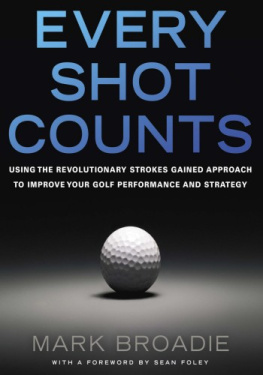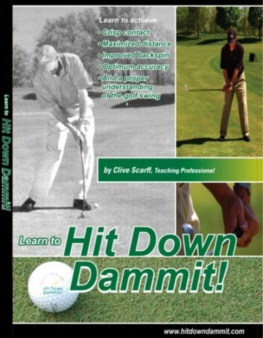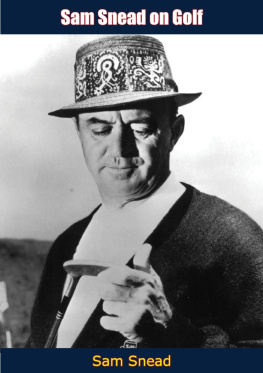THE
SCRAMBLERS
DOZEN
The 12 Shots
Every Golfer Needs to
Score Like the Pros
Mike McGetrick
with Tom Ferrell
A Mountain Lion Book

For my parents, Mack and Sandra McGetrick,
and my in-laws, Les and Jackie Timms,
for all of their love and support.
Contents
ONE
THE FADE
TWO
THE-BUMP-AND-RUN
THREE
THE LONG BALL
FOUR
THE FEATHERED IRON
FIVE
THE FLYER
SIX
THE HANGING LIE
SEVEN
LAG PUTTING
EIGHT
THE RUNNING CHIP
NINE
THE STANDARD PITCH
TEN
THE ONE-LEVER
ELEVEN
THE SPLASH SHOT
TWELVE
THE RESTRICTED SWING
The thing about golf is that you can never quite get a handle on it. Just when you think youve got the game figured out, you find yourself in a new situation and have to reach into your shotmaking bag of tricks. Thats what keeps golf interesting and fun, whether youre a Tour professional or a weekend player. Mike McGetrick has worked with golfers of every level, and he knows all about shotmaking. With Mikes help, Ive just finished the best year of my career, winning two major championships and earning a spot in the LPGA Hall of Fame. But it wasnt because my game was perfect. It was because I was more comfortable than ever before at hitting the shot that the moment required. Ill give you an example. At the 1999 U.S. Womens Open at Old Waverly Golf Club, I was on the seventh hole of the final round. I had a two-shot lead at the time, not much when you consider the caliber of the other golfers in contention. At the seventh, I hit my ball into a bunker, and it ended up in a buried lie. Rather than letting myself get uptight about my bad luck, I simply remembered my shotmaking fundamentals and played the shot. Fortunately, I was able to get the ball close, sink the putt for par and go on to win the championship. This book can help you develop that same kind of confidence. Mike shows you basic shotmaking techniques and then teaches you how to use those fundamentals to be able to execute a strategic shot in almost any situation the golf course can present. Mike also gives you some rules for practicing these shots so that youll be prepared when you need to hit them on the course. Believe me, this game is tough. Working with Mike has helped me find new ways to save strokes in almost every round. It will help you, too. Enjoy The Scramblers Dozen. I think youll find Mike to be as good a coach and friend to you as he is to me.
Juli Inkster,
1999 U.S. Womens Open and
LPGA Championship winner
Congratulations. By picking up this book, youve made a commitment to your golf game. And commitment is what it takes to improve your scoring. Golf is a simple game in theory, but as you know, the skills and techniques required to excel are very complex. Whether youre playing for a national championship, a club championship or simply trying to beat your personal best, you have to develop trust in your swing, your short game and your strategies. Tour players must trust their decisions and their ability to execute shots on the golf course in order to win tournaments and make a living. You have to do the same thing to get the greatest rewards from your golf experiences. In this book, Ill show you how, using the same methods I use when I coach some of the best players in the world.
Golfs most unique element is that no two rounds and no two courses are ever the same. Weather conditions change. So do ground conditions. Golf courses occupy flat sites and traverse hilly territory. A change as simple as the position of a pin can completely alter your shotmaking options. So golf is about adaptability, recognizing how conditions and circumstances will affect your shots and altering your strategy and execution to fit the specific requirements of the shot.
We marvel at the scores the Tour professionals shoot, and its true that most of us will never know what it feels like to fire a 65 on Sunday with the tournament on the line. Top professionals do it by squeezing every ounce out of their games. Like you, they dont hit the ball perfectly every time. They miss fairways and greens. They struggle in difficult conditions. But they also know what it takes to fade the ball around a tree or to hit a soft flop shot to a tough pin. When they find themselves in the fairway with 100 yards to the target, they know how to play a number of different shots depending on conditions. They understand when and how to chip or pitch or putt from off the green. And they know how to practice so that they are rarely in unfamiliar situations on the golf course. In other words, they give themselves scoring chances even when things are not going perfectly.
Anyone can play good golf on those magical days when every shot is pure and every putt is dropping. The key is to develop that sixth sense for scoringknowing how to get the ball into the hole from anywhere. Thats what I want to show you in this book. Scrambling isnt reserved only for your off-days. Good golfers scramble in every round. Good scramblers are always good scorers.
When I sat down to develop this book, I spent many hours determining which shots to include. The twelve shots I chose to feature are excellent additions to your golf game in and of themselves. But each of them is truly a jumping-off point that will allow you to develop not just a dozen new weapons but many, many more. Shotmaking is much more than simply curving the ball or hitting it low and high. Its understanding how the lie, the wind, the contour of the target and the hazards of the course will affect your decision-making process. As you develop a feel for these subtle differences, you will find yourself instinctively modifying the twelve featured shots to fit very specific needs. Thats when youre really playing golf.
And now, play away.

You can talk to a fade, but a hook wont listen.
Lee Trevino
Youve been playing golf long enough to know that, on the course at least, the shortest path between two points is rarely a straight line. To improve your scoring, you have to master the basic elements of shotmakingworking the ball from left to right and from right to left. The golf course never lets you rest. There are dogleg holes to contend with, tucked pins, wind conditions, trees and other obstacles. The player who has an idea how to affect the movement of the golf ball has a distinct advantage over the player who just hits and hopes.
In this chapter, well cover two of the basic shotmaking elementsthe left-to-right fade and the right-to-left draw. Whether you are a beginner, a scratch player or even a professional, you need to practice continuously to improve your shotmaking skills. As your shotmaking improves, youll find that not only are you playing better golf, youre having more fun.
FEATURED SHOT: THE FADE
Most weekend golfers live in fear of the slice. To them, a fade is often guilty by association. You should not undervalue the fade as a shotmaking choice, however, no matter what your skill level. Many of the games greatest players built their games around a fade. Recreational golfers often complain about a lack of consistency in their games. The fade is probably the most consistent shot they could develop. The elements that produce a fade already exist in their swings, they simply arent tamed enough to soften the left-to-right movement of the ball so as to make it predictable and useful.
Next page








